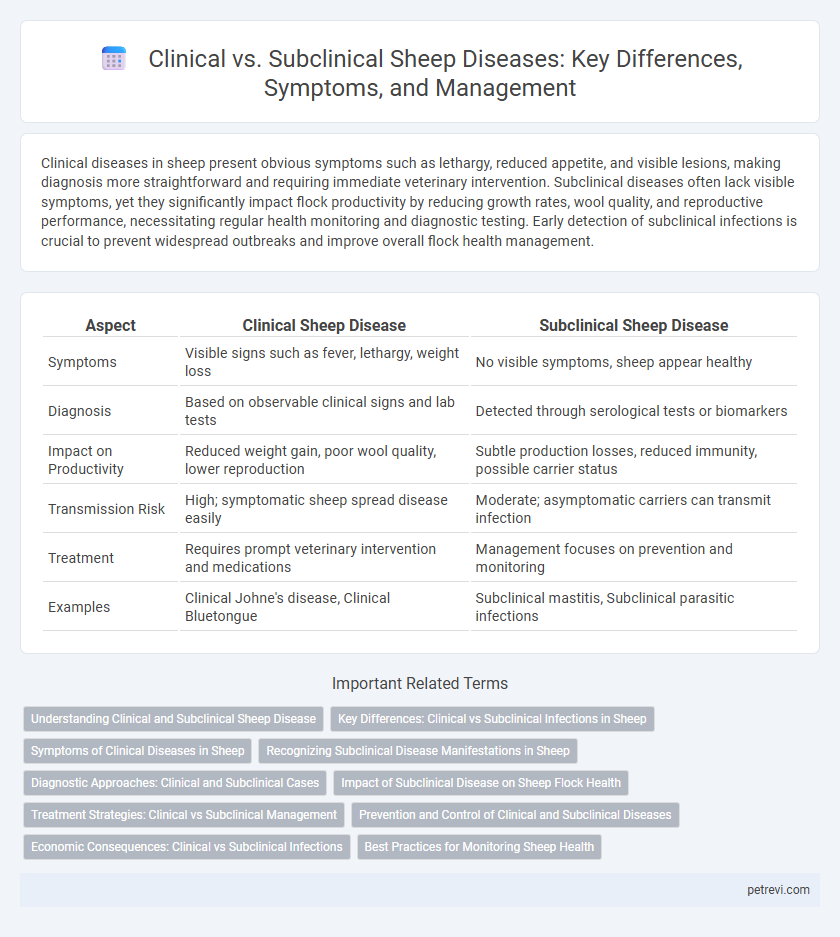Clinical diseases in sheep present obvious symptoms such as lethargy, reduced appetite, and visible lesions, making diagnosis more straightforward and requiring immediate veterinary intervention. Subclinical diseases often lack visible symptoms, yet they significantly impact flock productivity by reducing growth rates, wool quality, and reproductive performance, necessitating regular health monitoring and diagnostic testing. Early detection of subclinical infections is crucial to prevent widespread outbreaks and improve overall flock health management.
Table of Comparison
| Aspect | Clinical Sheep Disease | Subclinical Sheep Disease |
|---|---|---|
| Symptoms | Visible signs such as fever, lethargy, weight loss | No visible symptoms, sheep appear healthy |
| Diagnosis | Based on observable clinical signs and lab tests | Detected through serological tests or biomarkers |
| Impact on Productivity | Reduced weight gain, poor wool quality, lower reproduction | Subtle production losses, reduced immunity, possible carrier status |
| Transmission Risk | High; symptomatic sheep spread disease easily | Moderate; asymptomatic carriers can transmit infection |
| Treatment | Requires prompt veterinary intervention and medications | Management focuses on prevention and monitoring |
| Examples | Clinical Johne's disease, Clinical Bluetongue | Subclinical mastitis, Subclinical parasitic infections |
Understanding Clinical and Subclinical Sheep Disease
Clinical sheep disease manifests with visible symptoms such as fever, lameness, and loss of appetite, facilitating timely diagnosis and treatment. Subclinical infections often remain undetected due to the absence of obvious signs but cause reduced productivity and immune suppression, impacting overall flock health. Identifying subclinical cases requires targeted diagnostic tests like serology or PCR to control disease spread effectively.
Key Differences: Clinical vs Subclinical Infections in Sheep
Clinical infections in sheep present visible symptoms such as fever, lethargy, and respiratory distress, indicating an active immune response to pathogens like Mannheimia haemolytica or Clostridium perfringens. Subclinical infections, however, lack observable symptoms despite the presence of pathogens, potentially leading to decreased productivity, weight loss, and poor wool quality over time. Identifying these differences is crucial for effective disease management, vaccination strategies, and minimizing economic losses in sheep farming.
Symptoms of Clinical Diseases in Sheep
Clinical diseases in sheep present visible symptoms such as fever, lethargy, reduced appetite, lameness, respiratory distress, and diarrhea, indicating active infection or organ dysfunction. Common clinical signs include nasal discharge, coughing, swollen joints, and wool loss, which help distinguish overt disease from subclinical infections that show no apparent symptoms. Identifying these symptoms promptly aids in diagnosing conditions like foot rot, pneumonia, mastitis, or parasitic infestations, ensuring timely treatment and management.
Recognizing Subclinical Disease Manifestations in Sheep
Subclinical disease in sheep often presents without obvious symptoms, making early detection challenging but crucial for preventing widespread herd impact. Common indicators include subtle decreases in wool quality, mild weight loss, and reduced appetite, which require regular health monitoring and diagnostic testing such as blood work or fecal egg counts. Identifying subclinical infections enables timely intervention, improving overall flock health and productivity.
Diagnostic Approaches: Clinical and Subclinical Cases
Clinical cases of sheep disease present with visible symptoms such as lameness, swollen joints, or nasal discharge, allowing for straightforward diagnosis through physical examination and laboratory tests like bacterial culture or PCR. Subclinical infections lack obvious signs but require sensitive diagnostic approaches such as serological assays, ELISA, and advanced molecular techniques to detect pathogen presence or immune response in blood or tissue samples. Early identification of subclinical cases through these diagnostics is crucial for effective disease management and prevention of outbreaks in flocks.
Impact of Subclinical Disease on Sheep Flock Health
Subclinical disease in sheep often leads to reduced productivity, including lower weight gain, decreased wool quality, and impaired reproductive performance, without obvious clinical signs, making it difficult to detect and manage. This silent impact can result in significant economic losses due to decreased flock efficiency and increased vulnerability to secondary infections. Early detection through regular health monitoring and diagnostic testing is essential to mitigate the widespread effects of subclinical disease on flock health.
Treatment Strategies: Clinical vs Subclinical Management
Treatment strategies for sheep disease differ significantly between clinical and subclinical management. Clinical cases require immediate intervention with targeted medications such as antibiotics, antiparasitics, or anti-inflammatories to alleviate symptoms and prevent mortality. Subclinical management emphasizes herd-level monitoring, nutritional support, and strategic use of prophylactic treatments to reduce disease spread and improve overall flock productivity.
Prevention and Control of Clinical and Subclinical Diseases
Effective prevention and control of clinical and subclinical sheep diseases rely on regular health monitoring, vaccination programs, and biosecurity measures to minimize pathogen exposure. Identifying subclinical infections through diagnostic testing allows early intervention, reducing disease spread and production losses. Maintaining optimal nutrition and stress management strengthens immunity, enhancing resistance against both clinical and subclinical disease manifestations.
Economic Consequences: Clinical vs Subclinical Infections
Clinical infections in sheep lead to obvious symptoms such as fever, lethargy, and decreased feed intake, resulting in direct economic losses due to treatment costs, mortality, and reduced wool and meat production. Subclinical infections, although symptomless, cause hidden productivity declines including lower fertility rates, poor weight gain, and increased susceptibility to other diseases, leading to significant but often overlooked financial impacts on flock profitability. Effective detection and management of both clinical and subclinical diseases are crucial to minimizing overall economic losses in sheep farming.
Best Practices for Monitoring Sheep Health
Regular monitoring of sheep for clinical signs such as lameness, weight loss, and coughing is essential for early detection of overt diseases. Subclinical infections, often identified through routine diagnostic tests like blood profiles and fecal egg counts, can silently impact flock productivity and require proactive management. Incorporating both visual inspections and laboratory testing forms the best practice approach to maintaining optimal sheep health and preventing disease outbreaks.
Clinical vs Subclinical for Sheep Disease Infographic

 petrevi.com
petrevi.com